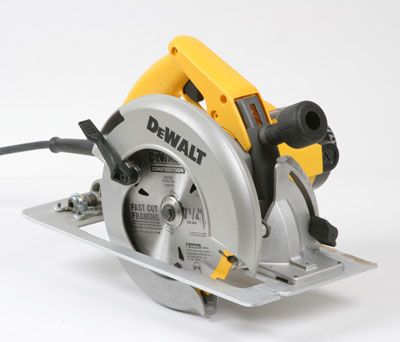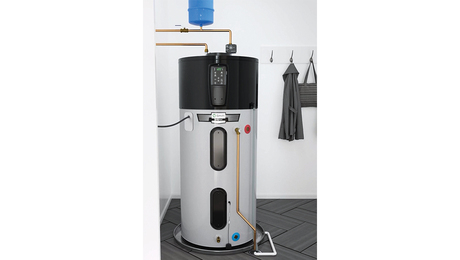DW364K Circular Saw
This enduring model traces it roots back to the venerable Black and Decker Saw Cat of decades ago, and is configured to adjust like no other saw out there. Its standout differences are the reason DeWalt has two saws in the test

Features:
Cutline markers: 90° Good, 45° Poor
Blade visibility: Fair
Guard operation: Very Good
Brake: Yes
Adjustments: Excellent. Depth adjusted by way of extra large arm mounted mid-shoe and locked in position with the front handle. Unique rear pivot helps keep shallow cuts on track by lowering its handle as you set the blade shallower. This is opposite of front pivot saws that swing their handles up toward a more horizontal position which requires you to drag the saw forward from the top rather than push from down low. Bevel set with giant, front-facing quadrant marked every 1° with cast-in numbers. No detents, but the generous size and accurate adjustable pointer allow for very precise settings.
Shoe: Stamped aluminum with the largest footprint and long, straight edges. Humped across width, humped across length. Aluminum surface had high friction on some materials.
Stability: Very Good, force applied to handles pushes straight down to shoe.
Grip comfort: Rear handle Good but bulky, trigger Fair due to square edges. Unique front handle centered on the shoe applies force straight down without causing any body flex.
Extras: Adjustable pointers on depth and bevel scales, and a unique shoe-to- blade parallelism adjustment. Odd cord minder to clip the power cord to the left side of the saw when in use.
Case: Plastic case
Flaws: Compared to a dead-on accurate DW364 I have used for many years, it seems as if this one was built with the shoe almost 1/8th inch off to the left. That’s the distance both cutline markers are off, as well as the distance needed to make the shoe-to-kerf measurements into numbers easier to figure when adding them to your cut length for sawing against a straightedge. I always remembered my 1-1/2- and 5-1/2-inch offsets, but users of the newest version might have a little harder time with 1-7/16- and 5-9/16+.
If I had to pick on anything else about the saw it would be the weight and the high friction of the aluminum shoe on some materials, though the sole should wear in smoothly in time.
Bottom Line: Big, heavy, and super stable. The old-school industrial vibe of this saw has its charms, but a handful of the newer generation of saws have bumped it from the top spot it held a few decades ago. Despite that opinion, it has its faithful—some guys [adherents] just won’t do without its unique handle action and fine adjustment capabilities. Perhaps that’s why it has remained in the catalog for so long. Or just maybe it’s because it was the second fastest cutter in the power test.























Comments are closed.